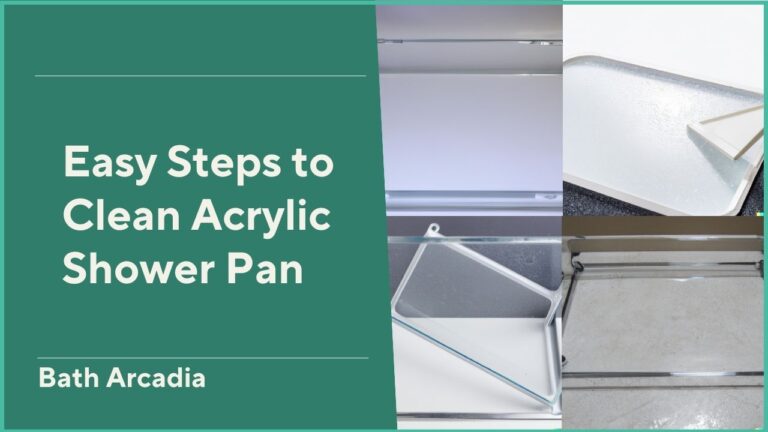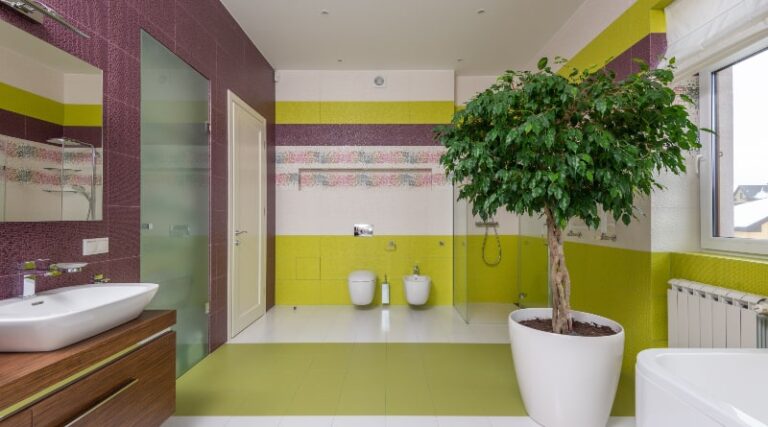White bathrooms have become popular as designers have transformed them into spa-like retreats. However, some argue going full white risks turning the space cold and sterile. This article explores the pros and cons of an all-white bathroom design and tips for balancing the crisp look with warmth and visual interest.
- The appealing qualities of an all-white bathroom
- Potential downsides of relying too heavily on white
- Designing with different white undertones
- Layering in natural textures
- Using tile, grout, and caulking in color
- Incorporating wall décor and soft lighting
- Making seasonal swaps and updates
- Create a serene haven with balance
- How to Choose the Right Artwork for an All-White Bathroom
- Artwork That Would Work Well in a White Bathroom?
- Conclusion
The appealing qualities of an all-white bathroom
When done right, an all-white bathroom offers several benefits:
It makes spaces feel more spacious
White’s reflective properties help bounce light around the room, making small bathrooms appear more airy and roomy. With white tile, countertops, walls, and fixtures, no dark colors compete for visual space.
It promotes cleanliness and hygiene
White surfaces are easier to clean and sanitary since dirt and residue appear clearly. This hygienic quality is particularly important in a bathroom prone to moisture issues like mold or mildew growth.
It’s a versatile and timeless look
White never goes out of style, pairing well with any decorative additions over time. Plus, white hides flaws and unevenness better than darker colors during installation.
It can create a relaxing, spa-like environment.
When balanced right, an all-white design’s light, bright qualities feel calm and soothing—perfect for a restorative bathroom retreat.
Potential downsides of relying too heavily on white
However, a few valid concerns arise from leaning too much into a stark white scheme:
It risks feeling cold and sterile
All white risks seem clinical rather than comfortable without warmth-infusing layers or textures.
Dirt shows up more
White’s transparency helps rooms look bigger but also makes scuffs, water spots, and stains harder to disguise over time in a high-traffic area.
It can lack personality and interest
Without tasteful accessorizing, pure white provides little unique character or dimension to catch the eye.
Additional maintenance is required
White pigments show aging signs sooner, needing diligent touch-ups, cleaning, and annual re-sealing of grout and tile to maintain a fresh look.
Designing with different white undertones
Rather than pure white, consider softer tones like these to make the space feel cozier:
Oyster white
With subtle blue undertones, oyster white comes across as soft and inviting.
Greige
A light grayish beige, greige combines the warmth of beige with the crispness of gray.
Cloud white
Seen in drifting clouds, cloud white brings a calming, ethereal quality versus severe brightness.
Dove white
Warmed slightly by peach tones, dove white feels gentle and relaxing rather than stark.
Choosing the right undertone sets the mood. Cool tones like porcelain white work best in modern farmhouse styles, while warm tones like oyster suit classic beach cottages.
Layering in natural textures
Adding natural materials grounds white bathrooms and offsets potential sterility:
- Stone, quartz, or concrete countertops paired with white subway tile backsplashes
- Reclaimed wood vanities and floating shelves
- Bamboo, seagrass, or jute rugs atop tile or porcelain floors
- Driftwood wall accents or shelves to display bundled herbs, seashells, or candles
Nature’s imperfections breathe visual interest into otherwise flat white spaces. Consider room proportions too—pairing white with wood works better in larger, open-concept powder rooms versus pocket-sized half baths.
Using tile, grout, and caulking in color
Rather than stark white grout lines, consider colors like:
- Dove grey for a soft background hue
- Charcoal or anthracite grey for drama
- Navy or teal for a coastal vibe
- Terracotta or blush pink for warmth
Colored grout and caulk infuse subtle dimensions without overwhelming the palette. Regularly re-seal slippery tile and re-apply caulk or grout sealer for upkeep.
Incorporating wall décor and soft lighting
White walls demand tasteful accents that don’t overpower the calm aesthetic:
- Matte gold or brass sconces with fabric-covered bulbs at dimmable settings
- Framed botanical prints, woven textiles, or geometric wallpaper in muted green, blue, or blush tones
- Floating shelves to display fresh flowers, rolling pins, or pottery in earthy hues
- Framed photos or mirrors above vanities and toilets
Natural light is key, too—skylights or large windows paired with white pleated shades drench the space without glare.
Making seasonal swaps and updates
Transform your all-white bathroom with regular updates to avoid monotony:
- swap potpourri or essential oil blends seasonally in wood bowls or jars
- refresh hand towels and window treatments for holidays or changing seasons
- paint an accent wall a new calming shade yearly
- update wall art or add framed botanical pressings seasonally
- switch out the ambiance with layered tea lights or LED pillar candles
Easy style refreshes breathe new life into white backdrops without major construction costs.
Create a serene haven with balance
With the right hands, an all-white bathroom transforms into a spa-like oasis. With thoughtful incorporation of materials, textures, lighting, and seasonal accents, white bathrooms showcase hygiene and calm comfort in one inviting space. Just be sure not to rely too heavily on stark whiteness alone—layering in soft undertones and natural elements keeps the design refreshing rather than sterile.
Considering Bathroom Layout
The layout of your bathroom is an important factor when deciding if all-white will work. More enclosed, small powder rooms are more challenging for an all-white look than open-concept bathrooms.
Consider lighter-colored cabinets, fixtures, and countertops in a smaller room instead of pure white. You’ll also need carefully placed task lighting over the vanity, toilet, and shower.
Skylights are ideal for larger bathrooms to let in natural light. Make sure windows aren’t too high up for smaller rooms, and use multiple sconces.
Material Usage
Strategically mixing materials adds layers without color. Consider a tile backsplash with a stone countertop or wood vanity. Textured wallpaper in one area or rippled glass for partitions adds visual interest.
Backsplashes don’t need to cover the full wall – a decorative strip tying into the countertop works. Pebble floors cool down an otherwise sterile space. Glass block or rippled glass shower walls emit light while maintaining privacy.
Accessorizing
Well-placed decorative accessories are key to not making a white bathroom feel bare. Incorporate various textures, shapes, and sizes.
Display natural elements like dried florals, seashells, frosted glass apothecary jars of cotton balls, or oils. Layer woven baskets, rolled towels, fragrant candles, and artisan soaps.
Change items seasonally – autumnal touches versus summery brights. Rotate artwork, and replace flowers weekly. Include sculptures, unique vases, framed prints, and photographs at varying heights.
Tailor your decor to the style and vibe. Coastal cottages suit nautical knots or anchors, while farmhouse baths pair well with galvanized metal signs and prints of herbs/fruits. Contemporary spaces look good with graphic wallpaper rolls or geometric art.
These additional details make the design options for balancing an all-white bathroom clearer. Let me know if any other topics would be helpful to include!
How to Choose the Right Artwork for an All-White Bathroom
Here are some tips for choosing the right artwork for an all-white bathroom:
- Go for framed artwork rather than unframed posters or prints, as frames add visual interest. Look for simple frames in brass, wood, or marble tones.
- Consider bathroom-safe materials like acrylic, metal, or saltwater-safe paper for anything hanging near moisture.
- Choose artwork with waterproof backing or mount pieces underneath glass for extra protection.
- To suit the space, incorporate framed nature or landscape photos that feature water elements like oceans, lakes, or waterfalls. Botanical illustrations also work well.
- Abstract or geometric artwork adds visual appeal without needing explanation. Look for pieces with calming color combinations.
- For small bathrooms, choose multiple smaller framed artworks versus one large centerpiece. This avoids overwhelming the space.
- Incorporate framed mirrors as “artwork” that also serves a function. Choose complimentary frames.
- Rotate art seasonally by theming pieces around foliage, seascapes, winter scenes, etc. This refreshes the space regularly.
- Use the room’s natural light when choosing artwork colors – darker tones work well in brighter rooms.
- Consider artwork that draws the eye if the room has low ceiling heights.
- Reference the bathroom’s design style when shopping – nautical pieces suit coastal, while botanicals pair well with nature-inspired baths.
With these tips, homeowners can curate the perfect complementary artwork collection for their all-white bathroom design. Proper placement and rotation keep things feeling fresh.
Artwork That Would Work Well in a White Bathroom?
Here are some additional art styles and media that can work well in an all-white bathroom:
- Wallpaper or mural panels – Try a removable or vinyl wallpaper with subtle patterns like dots, stripes, or floral for an accent wall. Or install half- or full-height mural panels.
- Photography or digital art prints – Bold landscape, floral or abstract images can incorporate color via museum-quality digital prints mounted on panels.
- Needlepoint or cross-stitch – Hung behind glass, samplers with decorative motifs add feminine charm.
- Calligraphy – Framed quotations highlighting wellness, nature, or positivity set a soothing tone.
- Pottery or ceramic tiles – Display handmade vessels, platters, or decorative tiles in soft neutrals.
- Macrame wall hangings – Air-dried plant hangers, dream catchers, or wall pockets soften the space.
- Calendars or date books – Swap out framed monthly or seasonal images for regular visual refreshment.
- Mirror mosaics – Modern renditions incorporating tile, mirror, or crystal pieces brighten while reflecting light.
- Whiteboard – A write-on/wipe-off board allows customized note-leaving on the go.
- Floating shelves – Showcase curated objects like stones, shells, or sculptures on open shelving.
Conclusion
An all-white bathroom can provide a clean and bright environment when balanced properly. Relying solely on stark white risks creating a sterile feel. However, softening the space with natural materials, subtle colors, accent lighting, and rotated artwork transforms it into a spa-like retreat.
With finesse, white uplifts interior design rather than presents limitations. Through curated accessorizing over time, homeowners can enjoy white’s versatility alongside a tailored and relaxing aesthetic. An all-white backdrop becomes a true sanctuary when balanced with warming details and visual interest.


